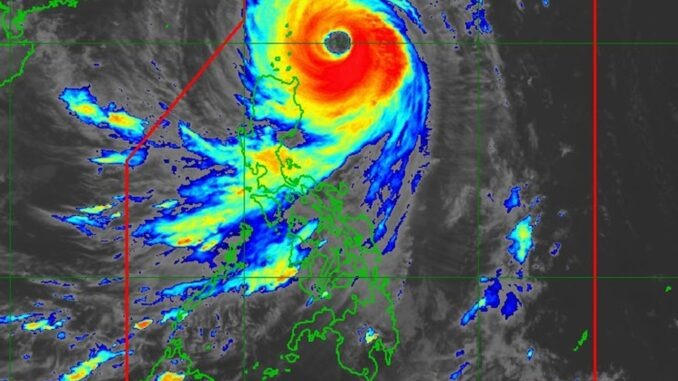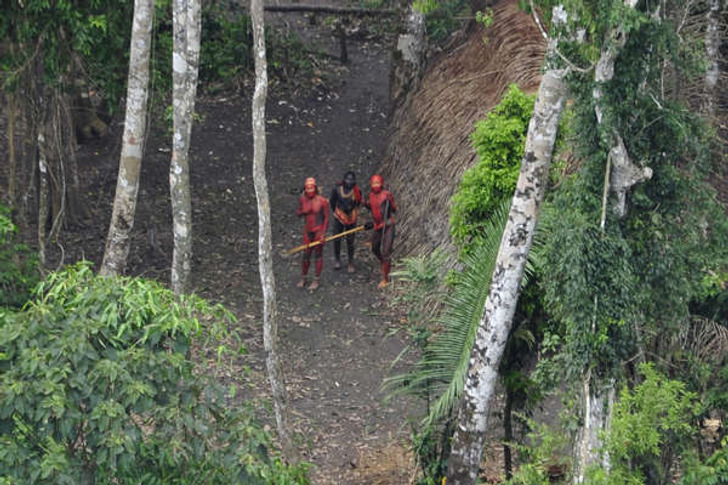
Ameteorologist has pointed out the sheer size of Typhoon Kong-rey’s eye as the massive storm approached Taiwan on Wednesday.
As of Wednesday afternoon, Typhoon Kong-rey had maximum sustained winds of 130 mph, according to the website Zoom Earth. The storm has weakened slightly since Tuesday night, when it was categorized as a super typhoon with maximum sustained winds of 150 mph, equivalent to a Category 4 hurricane. Forecasts anticipate that Typhoon Kong-rey will weaken further by the time it makes landfall in Kaohsiung in the early morning hours on Thursday.
On Tuesday night, meteorologist Noah Bergren of TV station WOFL in Orlando, Florida, commented on the size of the storm’s eye.
“Super Typhoon Kong-rey is easily one of the largest eye’s in a major tropical system you will ever see on Earth,” Bergren posted on X (formerly Twitter). “Thing is absolutely massive.”
A wave crashes outside of Fugang Harbor in Taitung, Taiwan, ahead of Typhoon Kong-rey on Wednesday. The storm is expected to make landfall in Taiwan early Thursday morning. Annabelle Chih/Getty
AccuWeather senior meteorologist Alan Reppert told Newsweek that having a large eye doesn’t necessarily imply anything about the storm’s strength.
“It just means the winds with it are farther away from the center than if it was a smaller eye,” he said. “It doesn’t necessarily have any major defining characteristic of the storm.”
Reppert added that a stronger storm that’s been around longer usually has a wider eye than a newer storm.
Most spaghetti models—or computer models illustrating potential storm paths—show Kong-rey making landfall on Taiwan’s southeast coast and cutting across the island before emerging with maximum sustained winds of around 75 mph. Models indicate that the typhoon will exhibit a northeastern turn away from China, which will take it out to the East China Sea.
Kong-rey’s strength is uncharacteristic for this time of year, The New York Times reported, adding that the typhoon is expected to make landfall equivalent to a Category 4 hurricane.
Reppert warned that strong winds up to 140 mph with higher gusts could hit southern Taiwan, though the storm is expected to weaken as it moves over the island. An AccuWeather report warned of “significant structural damage, mudslides and landslides” from the storm, as up to 3 feet of rain is expected to lash Taiwan. The storm could either maintain its intensity or strengthen before it makes landfall early Thursday.
Eastern China and Japan also are expecting heavy rain as the storm progresses.
A typhoon is classified as a severe tropical cyclone occurring in the Northwest Pacific. A hurricane is the term for the same type of storm in the Northeast Pacific and Northern Atlantic. Outside of these regions, the storms are called tropical cyclones.
Drone Captures Rare Images of Isolated People Who Are Cut Off From the World
G. Miranda’s breathtaking photographs, captured for Survival International, offer a rare glimpse into the secluded existence of various uncontacted tribes worldwide. From the enigmatic Sentinelese on North Sentinel Island, India, to the Amazon tribes near Brazil’s Javari River valley bordering Peru, these images provide a captivating aerial view.
The drone photographs are proof of the existence of untouched tribes.

A mesmerizing compilation video, shared on Death Island Expeditions’ YouTube channel in 2018, has garnered over 3.5 million views, showcasing these remote settlements and their inhabitants. Witness tribespeople, armed with traditional bows and arrows, gazing curiously at the hovering drones, offering a poignant insight into their untouched world.
It amuses people by showing the lives of tribespeople, which are different from ours.

Captivated viewers on YouTube expressed profound astonishment at the vast disparity between their lives and those of these tribespeople. One commenter marveled, “It blows my mind how different our lives are. The fact that they don’t even know about the existence of grocery stores, factories, phones, social media, everything that makes our society what it is. It’s so surreal.”
However, these untouched tribes are now in danger and need protection.

FUNAI, Brazil’s National Indian Foundation, plays a pivotal role in formulating policies concerning indigenous tribes, and their involvement in capturing drone footage underscores their commitment to preserving these cultures.
While some imagery dates back to 2008, as reported by Survival International, the significance of these visuals remains timeless, as emphasized by uncontacted tribes expert José Carlos dos Reis Meirelles Júnior. He highlighted the urgent need to protect these tribes from external threats, such as illegal logging activities encroaching from Peru.
“We did the overflight to show their houses, to show they are there, to show they exist,” he said.

A film has also been released. The Mission, a poignant documentary directed by Amanda McBaine and Jesse Moss, sheds light on the tragic fate of American missionary John Allen Chau. His ill-fated attempt to make contact with the Sentinelese people in 2018 resulted in his untimely demise, symbolizing the delicate balance between curiosity and respect for these isolated communities.
Another curious discovery occurred in Peru. The discovery of “alien mummies” at the airport has captured global attention, and scientists have revealed something disturbing.
Preview photo credit Death Island Expeditions / YouTube, G. Miranda/FUNAI/Survival



Leave a Reply